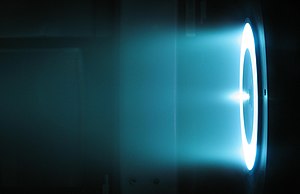
Back محرك دفع يعمل بتأثير هول Arabic Плазмен двигател Bulgarian Hallův motor Czech Hallantrieb German Propulsor a efecto Hall Spanish پیشرانه اثر هال FA Hall-ionimoottori Finnish Propulseur à effet Hall French מדחף אפקט הול HE Propulsore a effetto Hall Italian

In spacecraft propulsion, a Hall-effect thruster (HET) is a type of ion thruster in which the propellant is accelerated by an electric field. Hall-effect thrusters (based on the discovery by Edwin Hall) are sometimes referred to as Hall thrusters or Hall-current thrusters. Hall-effect thrusters use a magnetic field to limit the electrons' axial motion and then use them to ionize propellant, efficiently accelerate the ions to produce thrust, and neutralize the ions in the plume. The Hall-effect thruster is classed as a moderate specific impulse (1,600 s) space propulsion technology and has benefited from considerable theoretical and experimental research since the 1960s.[1]
Hall thrusters operate on a variety of propellants, the most common being xenon and krypton. Other propellants of interest include argon, bismuth, iodine, magnesium, zinc and adamantane.
Hall thrusters are able to accelerate their exhaust to speeds between 10 and 80 km/s (1,000–8,000 s specific impulse), with most models operating between 15 and 30 km/s. The thrust produced depends on the power level. Devices operating at 1.35 kW produce about 83 mN of thrust. High-power models have demonstrated up to 5.4 N in the laboratory.[2] Power levels up to 100 kW have been demonstrated for xenon Hall thrusters.
As of 2009[update], Hall-effect thrusters ranged in input power levels from 1.35 to 10 kilowatts and had exhaust velocities of 10–50 kilometers per second, with thrust of 40–600 millinewtons and efficiency in the range of 45–60 percent.[3] The applications of Hall-effect thrusters include control of the orientation and position of orbiting satellites and use as a main propulsion engine for medium-size robotic space vehicles.[3]
- ^ Hofer, Richard R. (June 2004). Development and Characterization of High-Efficiency, High-Specific Impulse Xenon Hall Thrusters. NASA Technical Reports Server (Report). hdl:2060/20040084644. NASA/CR – 2004-21309.
- ^ "Ion Thruster Prototype Breaks Records in Tests, Could Send Humans to Mars". space.com. 13 October 2017. Archived from the original on 20 March 2018. Retrieved 27 April 2018.
- ^ a b Choueiri, Edgar Y. (2009). "New Dawn for Electric Rockets". Scientific American. 300 (2): 58–65. Bibcode:2009SciAm.300b..58C. doi:10.1038/scientificamerican0209-58. PMID 19186707.